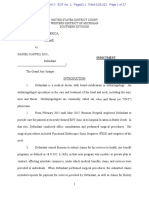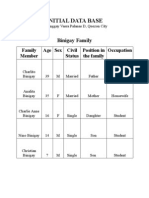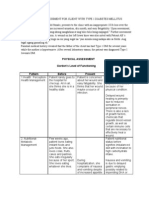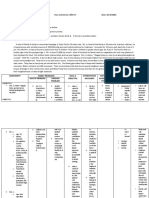University of Perpetual Help System DALTA: College of Radiologic Technology
University of Perpetual Help System DALTA: College of Radiologic Technology
Uploaded by
Jynrose Kaye GulpanyCopyright:
Available Formats
University of Perpetual Help System DALTA: College of Radiologic Technology
University of Perpetual Help System DALTA: College of Radiologic Technology
Uploaded by
Jynrose Kaye GulpanyOriginal Description:
Original Title
Copyright
Available Formats
Share this document
Did you find this document useful?
Is this content inappropriate?
Copyright:
Available Formats
University of Perpetual Help System DALTA: College of Radiologic Technology
University of Perpetual Help System DALTA: College of Radiologic Technology
Uploaded by
Jynrose Kaye GulpanyCopyright:
Available Formats
University of Perpetual Help System DALTA College of Radiologic Technology
KAWASAKI DISEASE BY: REYNALDO B. DIAZ I extent of dense consolidation on the right lower lobe. The doctor shifted antibiotics to ceftriaxone. The patient was still on strict monitoring on the 4th day, and was still experiencing fever. On hospital day 5, she suffered sustained high grade fever and developed cherry red eyes, strawberry tongue, erythematous eyes without exudates, erythema of hands and feet with slight edema, and polymorphous rash. Echocardiography performed on the 6th day of disease revealed dilation of left ventricle with mitral regurgitation. Additionally, a dilated left anterior descending artery (maximum diameter, 3.3 mm) was observed. A diagnosis of KD was then established. She was treated with IVIG (2 g/kg) and aspirin (80 mg/kg/day). The fever eventually subsided. Causes and Symptoms: The cause of Kawasaki disease is unknown, but it apparently develops in genetically predisposed individual after exposure to an as-yet-unidentified infectious agent. After the infection, altered immune function occurs. An increase in antibody production creates circulating immune complexes that bind to the vascular endothelium and cause inflammation. The inflammation of blood vessels leads to aneurysms, platelet accumulation, and the formation of thrombi or obstruction in the heart and blood vessels. In the case of the patient, she was exposed to the causative agent of pneumonia, which then led to the development of Kawasaki disease. Diagnosis: In order to diagnose Kawasaki disease, the patient should pass the following criteria: fever of 5 or more days duration, bilateral congestion of ocular conjunctivae, changes of the mucous membrane of the upper respiratory tract, changes of the peripheral
Introduction: Kawasaki disease or Mucocutaneous Lymph Node Syndrome is a febrile, multisystem disorder that occurs almost exclusively in children before the age of puberty. Vasculitis, or the inflammation of blood vessels, is the principal and lifethreatening finding because it can lead to formation of aneurysm and myocardial infarction. Kawasaki disease is the leading cause of acquired heart disease in children. Although about 80% of patients are under five years of age, older children and teenagers can also get KD, but this is uncommon. KD is more common in boys than girls, and the majority of cases are diagnosed in the winter and early spring. It is not contagious. Patient History: A previously healthy girl of 1 year old was hospitalized due to a 3-day history of fever and cough. Breath sounds were clear without crackles, and no cardiac murmur was audible. There were no other abnormal findings on physical examination. Chest radiograph revealed increased lung markings on the right perihilar area. She was treated with antibiotics, including amoxicillin clavulanate and clarithromycin, but the fever persisted. On the second day, the patient was ordered paracetamol for the fever. She was also given tepid sponge baths during fever episodes. The patient was on strict monitoring. The doctor ordered another chest radiograph on the 3rd day, and it showed an increased
University of Perpetual Help System DALTA College of Radiologic Technology
extremities, rash, and cervical lymph node swelling. The diagnostic test for confirming Kawasaki disease is Echocardiography. This painless test uses sound waves to create pictures of the heart and coronary arteries. It can also help show the diseases effect on your childs coronary artery. Other diagnostic test may include chest x-ray, blood tests, and electrocardiogram. Here is an illustrative example of coronary artery abnormalities:
Below is the picture of the patients chest radiograph on the third day:
Below is a sample picture of the 2D Echocardiogram of a patient with Kawasaki disease:
AP VIEW Findings: Patchy consolidation on the right upper lobe and perihilar area. (initial CXR) More increased extent of dense consolidation on the right lower lobe (3rd day CXR) Dilation of left ventricle with mitral regurgitation (2D Echo) Dilated left anterior descending artery (2D Echo)
Below is the picture of the patients initial chest radiograph:
Conclusion:
University of Perpetual Help System DALTA College of Radiologic Technology
Kawasaki disease is a fatal condition that requires immediate intervention. Because the etiology is unknown, it may be best that a predisposed child must regularly attend check-ups to assure that he/she is healthy. A childs exposure to infectious microorganisms must also be attended immediately. A compromised immune system makes a child more at risk in developing Kawasaki disease. The patients condition was really alarming before she was brought to the hospital. When serious and complicated symptoms exist in ones illness, one should seek medical attention immediately to avoid further complications that might lead to more serious diseases. References: Case taken from the University of Perpetual Help DALTA Medical Center Pillitteri, A. 2010. Maternal & Child Health Nursing. Philadelphia: Lippincott Williams & Wilkins http://www.nhlbi.nih.gov/health/healthtopics/topics/kd/diagnosis.html http://cdn.intechopen.com/pdfs/26295/ InTechEchocardiography_in_kawasaki_disea se.pdf
You might also like
- Daniel Castro IndictmentDocument27 pagesDaniel Castro IndictmentWWMTNo ratings yet
- Cva NCPDocument1 pageCva NCPxiang jinNo ratings yet
- Cholelithiasis Case StudyDocument6 pagesCholelithiasis Case StudySarah DentyNo ratings yet
- Open I Tibia Fibula (R) Lacerated Wounded Leg: Our Lady of Fatima UniversityDocument21 pagesOpen I Tibia Fibula (R) Lacerated Wounded Leg: Our Lady of Fatima UniversityPOTENCIANA MAROMANo ratings yet
- 1 - Perception and CoordinationDocument37 pages1 - Perception and CoordinationJek Dela CruzNo ratings yet
- Aging SensoryDocument8 pagesAging SensoryTjut Intan Permata SariNo ratings yet
- Dengue Hemorrhagic ShitDocument28 pagesDengue Hemorrhagic ShitRebecca FabonNo ratings yet
- Bea-Case StudyDocument21 pagesBea-Case Studybea pegadNo ratings yet
- Bea Case StudyDocument19 pagesBea Case StudyBea Flor Rapisura-PegadNo ratings yet
- Intracerebral Hemorrhage (CVA) : Angeles University Foundation College of Nursing A.Y. 2016-2017Document203 pagesIntracerebral Hemorrhage (CVA) : Angeles University Foundation College of Nursing A.Y. 2016-2017Reisabelle LabianoNo ratings yet
- IDBDocument2 pagesIDBPaulo PolinagNo ratings yet
- Burn Case StudyDocument4 pagesBurn Case Studyapi-232466940No ratings yet
- Spinal Cord Injury Case Study (Physical Assessment)Document3 pagesSpinal Cord Injury Case Study (Physical Assessment)TobiDaNo ratings yet
- CHF Group 3 Ncmb312 RleDocument39 pagesCHF Group 3 Ncmb312 RleMaica Lectana50% (2)
- Knowledge and Practices of Nurses in Infection Prevention and Control Within A Tertiary Care HospitalDocument4 pagesKnowledge and Practices of Nurses in Infection Prevention and Control Within A Tertiary Care HospitalAnonymous TzvMOnNo ratings yet
- Impact of Pandemic To The Psychological Aspects of Nursing StudentsDocument25 pagesImpact of Pandemic To The Psychological Aspects of Nursing StudentsBrandon AreteNo ratings yet
- Surgical Ward JournalDocument6 pagesSurgical Ward JournalMa Genille Samporna SabalNo ratings yet
- W 5Document1 pageW 5Chrisun CabalquintoNo ratings yet
- Uremic EncephalophatyDocument48 pagesUremic EncephalophatySindi LadayaNo ratings yet
- Review of Related Literature and Studies: EducationDocument19 pagesReview of Related Literature and Studies: EducationKatherine 'Chingboo' Leonico LaudNo ratings yet
- Grand Case Presentation (MI, COPD and BPH)Document80 pagesGrand Case Presentation (MI, COPD and BPH)Sarah Lim100% (2)
- Kawasaki DiseaseDocument7 pagesKawasaki DiseaseRitamariaNo ratings yet
- Nephrolithiasis: in The ClinicDocument16 pagesNephrolithiasis: in The ClinicJohnNo ratings yet
- CHN 2 JournalDocument2 pagesCHN 2 Journalinah krizia lagueNo ratings yet
- Case Study Final FractureDocument27 pagesCase Study Final Fracture3amabelle arevaloNo ratings yet
- Cefoxitin and Ketorolac Edited!!Document3 pagesCefoxitin and Ketorolac Edited!!Bryan Cruz VisarraNo ratings yet
- Stroke and Cerebrovascular DiseaseDocument14 pagesStroke and Cerebrovascular DiseaseMarwan M.No ratings yet
- Chronic Kidney Disease Secondary To Type 2 Diabetes MellitusDocument84 pagesChronic Kidney Disease Secondary To Type 2 Diabetes Mellituswar5No ratings yet
- History of Present IllnessDocument2 pagesHistory of Present IllnessReylan GarciaNo ratings yet
- Physical Assessment For Patient With DM Type1Document4 pagesPhysical Assessment For Patient With DM Type1Mae AzoresNo ratings yet
- Hepatic Encephalopathy: PRESENTER:Dr - Ch.Priyanka (DNB Junior Resident) Moderator: DR - Thirupathi Reddy (AssociateDocument19 pagesHepatic Encephalopathy: PRESENTER:Dr - Ch.Priyanka (DNB Junior Resident) Moderator: DR - Thirupathi Reddy (AssociatePriyanka ChinthapalliNo ratings yet
- Care of ElderlyDocument23 pagesCare of Elderlyifer_018No ratings yet
- Hydatidiform MoleDocument64 pagesHydatidiform MoleLawrence CapuchinoNo ratings yet
- Spinal Cord Injury Case Study (Nursing History)Document5 pagesSpinal Cord Injury Case Study (Nursing History)TobiDaNo ratings yet
- Health and Privacy PDFDocument40 pagesHealth and Privacy PDFMonika NegiNo ratings yet
- Operating Room Write UpDocument2 pagesOperating Room Write UpEnrico Sapitula Del RosarioNo ratings yet
- Nursing Care Plan CVADocument5 pagesNursing Care Plan CVALhyn MacogayNo ratings yet
- Velez College of Nursing F. Ramos Street, Cebu CityDocument57 pagesVelez College of Nursing F. Ramos Street, Cebu Cityinah krizia lagueNo ratings yet
- Case Analysis For FNCPDocument6 pagesCase Analysis For FNCPOfficially RandomNo ratings yet
- Health 2 - Part B-Older Adult Community Health AssignmentDocument23 pagesHealth 2 - Part B-Older Adult Community Health AssignmentNicole PattenNo ratings yet
- Case Pres A1-RhdDocument11 pagesCase Pres A1-RhdCharm TanyaNo ratings yet
- Ateneo de Zamboanga University: Nursing Skills Output (Nso)Document9 pagesAteneo de Zamboanga University: Nursing Skills Output (Nso)Mitzi BelamideNo ratings yet
- Risk For SuicideDocument3 pagesRisk For SuicidepamfiestaNo ratings yet
- AFPMC V. Luna General Hospital: Case StudyDocument27 pagesAFPMC V. Luna General Hospital: Case StudyLemuel GuevarraNo ratings yet
- Kawasaki DiseaseDocument38 pagesKawasaki DiseaseJayson CabarceNo ratings yet
- Newest Research Paper The Challenges of Student Nurses in Their Clinical Skills Development Using Digital Technology. UwuDocument50 pagesNewest Research Paper The Challenges of Student Nurses in Their Clinical Skills Development Using Digital Technology. UwuMaryan SubaldoNo ratings yet
- Nodular Goiter Concept MapDocument5 pagesNodular Goiter Concept MapAllene PaderangaNo ratings yet
- Multiple Physical Injuries Secondary To Vehicular AccidentDocument31 pagesMultiple Physical Injuries Secondary To Vehicular AccidentJane Arian BerzabalNo ratings yet
- Case Study Tension Pneumothorax BSN 4 2 1Document57 pagesCase Study Tension Pneumothorax BSN 4 2 1aaron tabernaNo ratings yet
- Case Analysis On Geriatrics FinalDocument30 pagesCase Analysis On Geriatrics Final3D - AURELIO, Lyca Mae M.No ratings yet
- Lourlyn's Angels?Document27 pagesLourlyn's Angels?lovelove DayoNo ratings yet
- RRS at RRLDocument19 pagesRRS at RRLNicole MangosanNo ratings yet
- Manuscript-research-Impact With CorrectionsDocument88 pagesManuscript-research-Impact With CorrectionsJay VillasotoNo ratings yet
- Stevens Johnson Syndrome CASEDocument53 pagesStevens Johnson Syndrome CASEKathrina CraveNo ratings yet
- CTC 2.18 Open-Angle Glaucoma PDFDocument29 pagesCTC 2.18 Open-Angle Glaucoma PDFNorvim LascanoNo ratings yet
- UTI (Urinary Tract Infection)Document9 pagesUTI (Urinary Tract Infection)Carson BirthNo ratings yet
- Chronic Kidney FailureDocument9 pagesChronic Kidney FailureKrizzy MontanaNo ratings yet
- Covid19 - Pathophysiology and ManagementDocument51 pagesCovid19 - Pathophysiology and ManagementMyraflor CaroNo ratings yet
- Research SemidoneeDocument27 pagesResearch SemidoneeSHARMAINE ANNE POLICIOSNo ratings yet
- Ventricular Septal Defect, A Simple Guide To The Condition, Treatment And Related ConditionsFrom EverandVentricular Septal Defect, A Simple Guide To The Condition, Treatment And Related ConditionsNo ratings yet
- The Ride of Your Life: What I Learned about God, Love, and Adventure by Teaching My Son to Ride a BikeFrom EverandThe Ride of Your Life: What I Learned about God, Love, and Adventure by Teaching My Son to Ride a BikeRating: 4.5 out of 5 stars4.5/5 (2)
- Clot Expands: Deformity/injury To The EndocardiumDocument2 pagesClot Expands: Deformity/injury To The EndocardiumJynrose Kaye GulpanyNo ratings yet
- Open Heart Surgery-Post Op CareDocument6 pagesOpen Heart Surgery-Post Op CareJynrose Kaye Gulpany100% (5)
- University of Perpetual Help System DALTA: College of Radiologic TechnologyDocument2 pagesUniversity of Perpetual Help System DALTA: College of Radiologic TechnologyJynrose Kaye GulpanyNo ratings yet
- Discharge PlanningDocument1 pageDischarge PlanningJynrose Kaye GulpanyNo ratings yet
- AscitesDocument63 pagesAscitesfeeo8266No ratings yet
- To Be or Not To Be Hallucinating: Implications of Hypnagogic/hypnopompic Experiences and Lucid Dreaming For Brain DisordersDocument11 pagesTo Be or Not To Be Hallucinating: Implications of Hypnagogic/hypnopompic Experiences and Lucid Dreaming For Brain DisorderslacasadelpianistaNo ratings yet
- 25 Powerful Little Known Anti Aging TipsDocument36 pages25 Powerful Little Known Anti Aging Tipsmaxim ivanov100% (1)
- Teicoplanin Prescribing and Therapeutic Drug Monitoring Clinical Guideline V2.0 March 2019Document12 pagesTeicoplanin Prescribing and Therapeutic Drug Monitoring Clinical Guideline V2.0 March 2019nancy voraNo ratings yet
- 2017 USRDS Annual Data Report Executive SummaryDocument8 pages2017 USRDS Annual Data Report Executive SummaryTony Miguel Saba SabaNo ratings yet
- Adobe Scan Jan 26, 2024Document2 pagesAdobe Scan Jan 26, 2024Karthik NatarajanNo ratings yet
- MOHAN RESUME FinalDocument4 pagesMOHAN RESUME Finalyeluru mohanNo ratings yet
- Mano - Syllabus - ChakrasDocument7 pagesMano - Syllabus - ChakrasMustafa AliNo ratings yet
- MCQs NeuroDocument2 pagesMCQs NeuroBagadi Suneel100% (2)
- hcr263 Group Activity Coding Presentation 3Document19 pageshcr263 Group Activity Coding Presentation 3api-682342806No ratings yet
- Summary ExercisesDocument2 pagesSummary ExercisesNorsaniah Ismail100% (1)
- Kidney StonesDocument2 pagesKidney StonesNick BantoloNo ratings yet
- Neonatal Polycythemia: Is Partial Exchange Transfusion Justified?Document9 pagesNeonatal Polycythemia: Is Partial Exchange Transfusion Justified?Lulú PérezNo ratings yet
- Nihms 1028044Document18 pagesNihms 1028044NormanNo ratings yet
- AIIMS PG Focus Guide-With AppDocument28 pagesAIIMS PG Focus Guide-With AppJyotiprakash KanjilalNo ratings yet
- Ijss-Cr 1 (4) CR 01Document4 pagesIjss-Cr 1 (4) CR 01Ikramullah MahmuddinNo ratings yet
- Autonomic Nervous SystemDocument6 pagesAutonomic Nervous SystemSUTHAN100% (4)
- Thesis On FundraisingDocument5 pagesThesis On Fundraisingk1lod0zolog3100% (2)
- Anatomy and PhysiologyDocument2 pagesAnatomy and PhysiologyPrecious UncianoNo ratings yet
- Spiritual NCPDocument6 pagesSpiritual NCPMaricel R. ManabatNo ratings yet
- 54L EutectrodeDocument9 pages54L EutectrodeJuan LondonoNo ratings yet
- ISC Class XII Question Bank For Annual Exam - ENGLISHDocument18 pagesISC Class XII Question Bank For Annual Exam - ENGLISHRishav VermaNo ratings yet
- Bai Tap Doc Hieu 1Document10 pagesBai Tap Doc Hieu 1Tâm HoàngNo ratings yet
- Enzymes NPDocument25 pagesEnzymes NPBharatShethNo ratings yet
- WATER TREATMENT Case Study 2020Document14 pagesWATER TREATMENT Case Study 2020Aidyl Kate BernalNo ratings yet
- AJODO-99 3er Molar Un Dilema PDFDocument6 pagesAJODO-99 3er Molar Un Dilema PDFJorge Armando LópezNo ratings yet
- 6 BadranDocument6 pages6 BadranAjibola SolomonNo ratings yet
- Clostridium Botulinum in Vacuum Packed (VP) FoodDocument225 pagesClostridium Botulinum in Vacuum Packed (VP) FoodRemya PillaiNo ratings yet
- Self Management Berhubungan Dengan: Keywords: Self Management, Quality of Lifestyle, Chronic Kidney Disease, HemodyalisisDocument9 pagesSelf Management Berhubungan Dengan: Keywords: Self Management, Quality of Lifestyle, Chronic Kidney Disease, HemodyalisisAn anonymousNo ratings yet





























































































